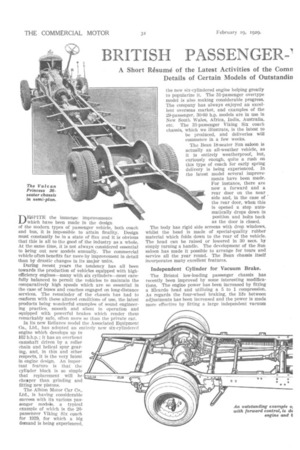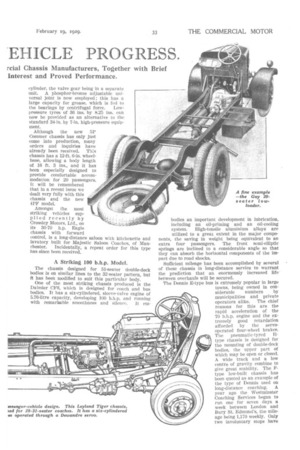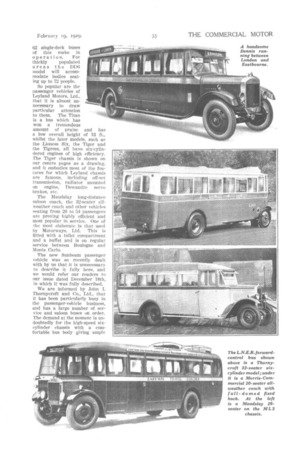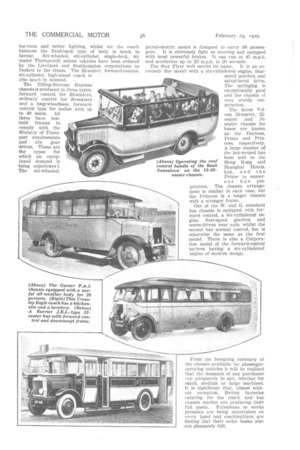a ITISH PASSENGE 1 11
Page 122

Page 123

Page 124

Page 125

Page 126

If you've noticed an error in this article please click here to report it so we can fix it.
EHICLE P
11
OGRESS
DEms'PITE the immense improvements which have been made in the design of the modern types of passenger vehicle, both coach and bus, it is impossible to attain finality. Design must constantly be in a state of flux and it is obvious that this Is all to the good of the industry as a whole. At the same time, it is not always considered essential to bring out new models annually. The commercial vehicle often benefits far more by improvement in detail than by drastic changes in its major units.
During recent years the tendency has all been towards the production of vehicles equipped with highefficiency engines—many with six cylinders—most carefully balanced to permit the vehicles to maintain the comparatively high speeds which are so essential in the case of buses and coaches engaged on long-distance services. The remainder of the chassis has had to conform with these altered conditions of Use, the latest products being wonderful examples of sound engineering practice, smooth and silent in operation and equipped with powerful brakes which render them remarkably safe, often more so than the private car.
In its new Reliance model the Associated Equipment Co., Ltd., has adopted an entirely new six-eylindered engine which develops up to 102 b.h.p.: it has an overhead camshaft driven by a roller chain and helical spur gearing, and, in this and other respects, it is the very latest in engine design. An important feature is that the cylinder block is so simple that replacement will he cheaper than grinding and fitting new pistons.
The Albion Motor Car Co., Ltd., is having considerable success with its various passenger mode, a typical example of which is the 26passenger Viking Six coach for 1929, for which a big demand is being experienced. the new six-cylindered engine helping greatly to popularize it. The 31-passenger overtype model is also making considerable progress. The company has always enjoyed an excellent overseas market, and examples of the 29-passenger, 30-60 h.p. models are in use in New South Wales, Africa, India, Australia, etc. The 31-passenger Viking Six coach chassis, which we illustrate, is the latest to be produced, and deliveries will commence in a few weeks.
The Bean 18-seater Sun saloon is actually an all-weather vehicle, as it is entirely weatherproof, but, curiously enough, quite a rush on this type of coach for early spring delivery is being experienced. In the latest model several improvements have been made. For instance, there are now a forward and a rear door on the near side and, in the case of the rear door, when this is opened a step automatically drops down in position and bolts back as the door is closed.
The body has rigid side screens with drop windows, whilst the head is made of special-quality rubber material which folds down to the rear of the vehicle. The head can be raised or lowered in 30 sees. by simply turning a handle. The development of the Sun saloon has made it possible to arrange for tours and service all the year round. The Bean chassis itself incorporates many excellent features.
Independent Cylinder for Vacuum Brake.
The Bristol low-loading passenger chassis has recently been improved by some interesting modifications. The engine power has been increased by fitting a Ricardo head and utilizing a 5 to 1 compression. As regards the four-wheel braking, the life between adjustments has been increased and the power is made more effective by fitting a large independent vacuum cylinder, the valve gear being in a separate unit. A phosphor-bronze adjustable universal joint is now employed; this has a large capacity for grease, which is fed to
the bearings by centrifugal force. Lowpressure tyres of 36 ins. by 8.25 ins, can now be provided as an alternative to the standard 34-in. by 7-in, high-pressure equipment.
Although the new 5P Commer chassis has only just come into production, many orders and inquiries have already been received. This chassis has a 12-ft. 6-in, wheelbase, allowing a body length of 16 ft. 3 ins., and it has been especially designed to provide comfortable accommodation for 20 passengers. It will be remembered that in a recent issue we dealt very fully with this chassis and the new 4PF model.
Amongst the most striking vehicles supplied recently by Crossley Motors, Ltd., on its 30-70 h.p. Eagle chassis with forward control, is a long-distance saloon with kitchenette and lavatory built for Majestic Saloon Coaches, of Man chester. Incidentally, a repeat order for this type has since been, received.
A Striking 100 b.h.p. Model.
The chassis designed for 51-seater double-deck bodies is on similar lines to the 32-seater pattern, but ft has been modified to suit this particular body.
One of the most striking chassis produced is the Daimler C106, which is designed for coach and bus bodies. It has a six-cylindered, sleeve-valve engine of 5.76-litre capacity, developing 100 b.b.p. and running with remarlkable smoothness and silence. It ern
bodies an important development in lubrication, including an oil-priming and an oil-cooling system. High-tensile aluminium alloys are utilized to a great extent in the major components, the saving in weight being equivalent to an extra four passengers. The front semi-elliptic springs are inclined to a considerable angle so that they can absorb the horizontal components of the impact due to road shocks.
Sufficient mileage has been accomplished by several of these chassis in long-distance service to warrant the prediction that an enormously increased life between overhauls will be secured.
The Dennis E-type bus is extremely popular in large towns, being owned in considerable numbers by municipalities and private operators alike. The chief reasons for this are the rapid acceleration of the 70 b.h.p. engine and the extremely good retardation afforded by the servooperated four-wheel brakes. The pneumatic-tyred
type chassis is designed for the mounting of double-deck bodies, the upper part of which may be open or closed. A wide track and a low centre of gravity combine to give great stability. The Ftype low-built chassis has been quoted as an example of the type of Dennis used on long-distance coaching. A year ago the Westminster Coaching Services began to run one for seven days a week between London and Bury St. Edmund's, the mileage being 1,170 weekly. Only two involuntary stops have
been recorded, both due to accidental damage. As a result, eight more machines of this type were supplied.
A very neat little Garner chassis is built to carry 20-seater bus or coach bodies. This is known as the P.A., or the P.A.J., according to the size of the engine. The frame line is straight throughout, and the engine, clutch and gearbox form a unit. Ten frame outriggers are supplied for body widths up to 7 ft. 2 ins.
Perhaps one of the most successful long-d istance coach chassis on the British market is the Gilford, large numbers of users operating this make. Under a year ago the company started an important works at High Wycombe and is now about to add another large bay, an acre in extent. Production is already over 100 per cent. in excess of last year, and this extension of the works will enable it to be increased still further.
A very large number of Guy passenger chassis of various types and capacities up to 72-seater sixwheelers is in use throughout the country. The 20-seater chassis, of which we publish an illustration, is a very popular model, with a road speed of 16.5 m.p.h. at 1,000 r.p.m. It has a frame dropped at the dash and arched over the back axle. The 35-seater is arranged for forward control, and it has the four
cylindered engine embodying the patented Guy features, a flexiblesub-frame and oil lubrication throughout.
Halley Motors, Ltd., has experienced a good demand for the new Conqueror bus, and production has had to be speeded up to meet requirements. The main points which have appealed to buyers are the excellent engine performance, quietness in operation of the gears, the flexible chassis suspension, robust construction and the adoption of central chassis lubrication.
The CIA mode/ Karrier has a normal capacity of 26 as a bus or coach, but so generous is the body space that it will give comfortable seating accommodation for up to 29
passengers. With a Ricardo-headed engine and a 6 to 1 rear axle ratio, it can give a fast cruising speed. The J.K.L. model is a popular medium-capacity vehicle with improved springing, braking, steering and lubrication, whilst the WL6 is the well-known rigidframe six-wheeler for single-deck bodies seating from 37 to 40 people. Liverpool Corporation Tramways has
62 single-deck buses of this make in operation. For thickly populated areas the DD6 model will accommodate bodies seat
ing up to 72 people.
So popular are the passenger vehicles of Leyland Motors, Ltd., that it is almost unnecessary to draw particular attention to them. The Titan is a bus which has won a tremendous amount of praise and has a low overall height of 13 ft., whilst the later models, such as the Lioness Six, the Tiger and the Tigress, all have six-cyfintiered engines of high efficiency. The Tiger chassis is shown on our centre pages as a drawing, and it embodies most of the features for which Leyland chassis are famous, including off-set transmission, radiator mounted on engine, Dewandre servo brakes, etc.
The Maudslay long-distance saloon coach, the 32-seater aIlweather coach and other vehicles seating from 26 to 54 passengers are proving highly efficient and most popular in service. One of the most elaborate is that used by Motorways, Ltd. This is fitted with a toilet compartment and a buffet and is on regular service between Boulogne and Monte Carlo.
The new Sunbeam passenger vehicle was so recently dealt with by us that it is unnecessary to describe it fully here, and we would refer our .readers lo our issue dated December 18th, in which it was fully described.
We are informed by John I. Thornycroft and Co., Ltd., that it has been particularly busy in the passenger-vehicle business, and has a large number of service and saloon buses on order. The demand at the moment is undoubtedly for the high-speed sixcylinder chassis with a comfortable bus body giving ample
leg-room and better lighting, whilst for the coach business the fixed-back type of body is much in favour. Six-wheeled, six-cylinder, single-deck, 40seater Thornycroft saloon vehicles have been ordered by the Liverpool and Southampton corporations as feeders to the trams. The 32-seater, forward-control, six-cylinder, high-speed coach is also much in demand.
The Tilling-Stevens Express chassis is produced in three types, forward control for 32-seaters, ordinary control for 30-seaters and a long-wheelbase, forwardcontrol type for bodies with up to 40 seats. All three have lowbuilt frames to comply with the Ministry of Transport requirements and are gear driven. These are the types for which an exceptional demand is being experiencel. The six-wheeled,
petrol-electric model is designed to carry 68 passengers. It is extremely light on steering and equipped with most powerful brakes. It can run at 45 m.p.h. and accelerate up to 20 m.p.h. in 20 seconds.
The Star Flyer well merits its name. It is an extremely fine model with a six-cylindered engine, fourspeed gearbox and spiral-bevel drive. The springing is exceptionally good and the chassis of very sturdy construction.
The latest Vulcan 26-seater, 82seater and :16seater chassis for buses are known as the Duchess, Prince and Princess, respectively. A large number Of the last-named has been sold to the Hong Kong and Shanghai Hotels. Ltd., and the Prince to numerous bus proprietors. The chassis arrangement is similar in each case, but the Princess is a longer chassis with a stronger frame.
One of the W. and G. standard bus chassis is equipped with forward control, a six-cylindered engine, four-speed gearbox and worm-driven rear axle, whilst the second has normal control, but is otherwise the same as the first model. There is also a Corporation model of the forward-control pattern having a six-cylindered engine of modern design.
From the foregoing summary of the chassis available for passengercarrying vehicles it will be realized that the demands of any purchaser can adequately be met, whether for small, medium or large machines. It is significant that, almost without exception, British factories catering for the coach and bus chassis market are producing their full quota. Extensions to works premises are being undertaken on every hand and coachbuilders are finding that their order books also are pleasantly full.




























































































































































































































